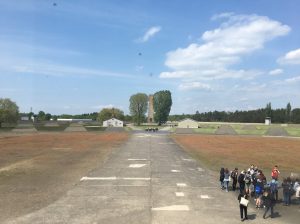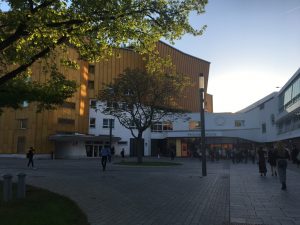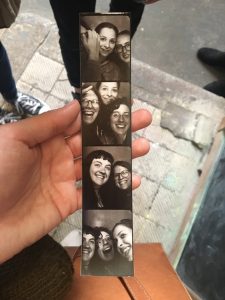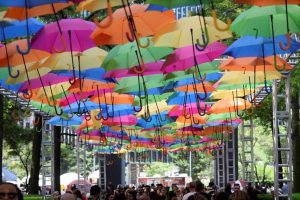By Melanie Landsittel, OIA Student worker
During the first two weeks of May, 2018, I was able to attend Chatham’s short term field experience program in Berlin and Brussels and in the following post I will describe my experience in Berlin.
To me, Berlin is an extremely livable city. Its wide open spaces, rivers, and abundance of public green space are unlike any other place. Getting around is easy with the subway and tram system as well. Another great thing about it is the food—there is a huge variety of what you can eat in Berlin, and most of it is great, like New-York level food.
The above picture is me, being touristy and taking a picture by the Brandenburg gate. The area we stayed in, in general, was a bit touristy, but it really wasn’t too crowded which I was impressed by.
Here you can see what I mean by open spaces. This picture also shows how clean of a city Berlin is, it’s extremely impressive. For those of you who haven’t visited Europe, you may be surprised to know that most public bathrooms here, and in other cities around the continent, charge 50 cents to 1 euro on average to use the public restroom. This may seem a little bizarre, but… honestly it’s kind of worth it because they are so clean!
On this field experience, we had several opportunities to visit sites related to German history. One of these is pictured above—The Sachsenhausen Concentration Camp. It was really a sobering experience, the tour guide described the structure to us as a “geometry of terror.” I didn’t quite get what he meant until I glanced out this window—the whole structure is enclosed in a giant triangular wall, the rows of camps forming semicircles facing the gate. It was quite jarring to look at, and to contemplate what had taken place here. It’s kind of beyond words for me.
We also visited the Stasi Archives. These were where the East German secret police kept their files on citizens. An estimated 51% of the East German population was associated with the Stasi in some way, as official or unofficial spies, according to our tour guide. She recounted to us a story about a woman whose husband had been spying on her for years and she had no idea. Nowadays, citizens of the former East Germany can request that their file be released, but the average processing time is about 2 years. When I think about it, I’m not sure if I would want my file or not—imaging finding out that one of your parents or sibling had been giving the Stasi your private information!
On a lighter note, we also took a short bus ride to the city of Potsdam to visit the castles of old Prussian kings, as well as the offices of the Potsdam conference. The castle pictured above, Sans Souci (Without Worry) was the home of Fredrick the Great King of Prussia… and his 11 greyhounds. He loved these dogs so much, he had them buried next to him on the grounds of the castle. Potsdam is quite the gem of a city—I highly recommend taking the time to visit!
In our free time, we were able to roam around the city, using our transit pass for the subway and the tram. Berlin is very large with so much to do, so we didn’t have any trouble keeping ourselves busy. One treasure that we stumbled upon was the Jacob und Wilhelm Grimm Zentrum, the Humboldt Universität zu Berlin Library. Pictured above is a view of the library’s astounding architecture—this style is characteristic of the Bauhaus movement in Germany, which is also very popular in the United States! Many famous Bauhaus artists moved to the USA to escape WWII.
On our last night in Berlin, a group of us managed to buy tickets to the Berlin Philharmonic. This was an amazing experience, especially as a fan of classical music, it’s probably the most famous orchestra hall in the world. We saw a group from Berlin University of the Arts’ rendition of Mahler 9—it was absolutely incredible.
As far as Berlin goes, there’s plenty to do to experience the culture, enjoy yourself, and learn about German history.
Tschüss! (It means bye, people didn’t really say Auf Wiedersehen)
Melanie Landsittel is a senior at Chatham, majoring in Visual Arts: with a double concentration in Studio Art and Art History. Melanie works in the Office of International Affairs.
Interested in study abroad? Contact internationalaffairs@chatham.edu to find out about options available!








